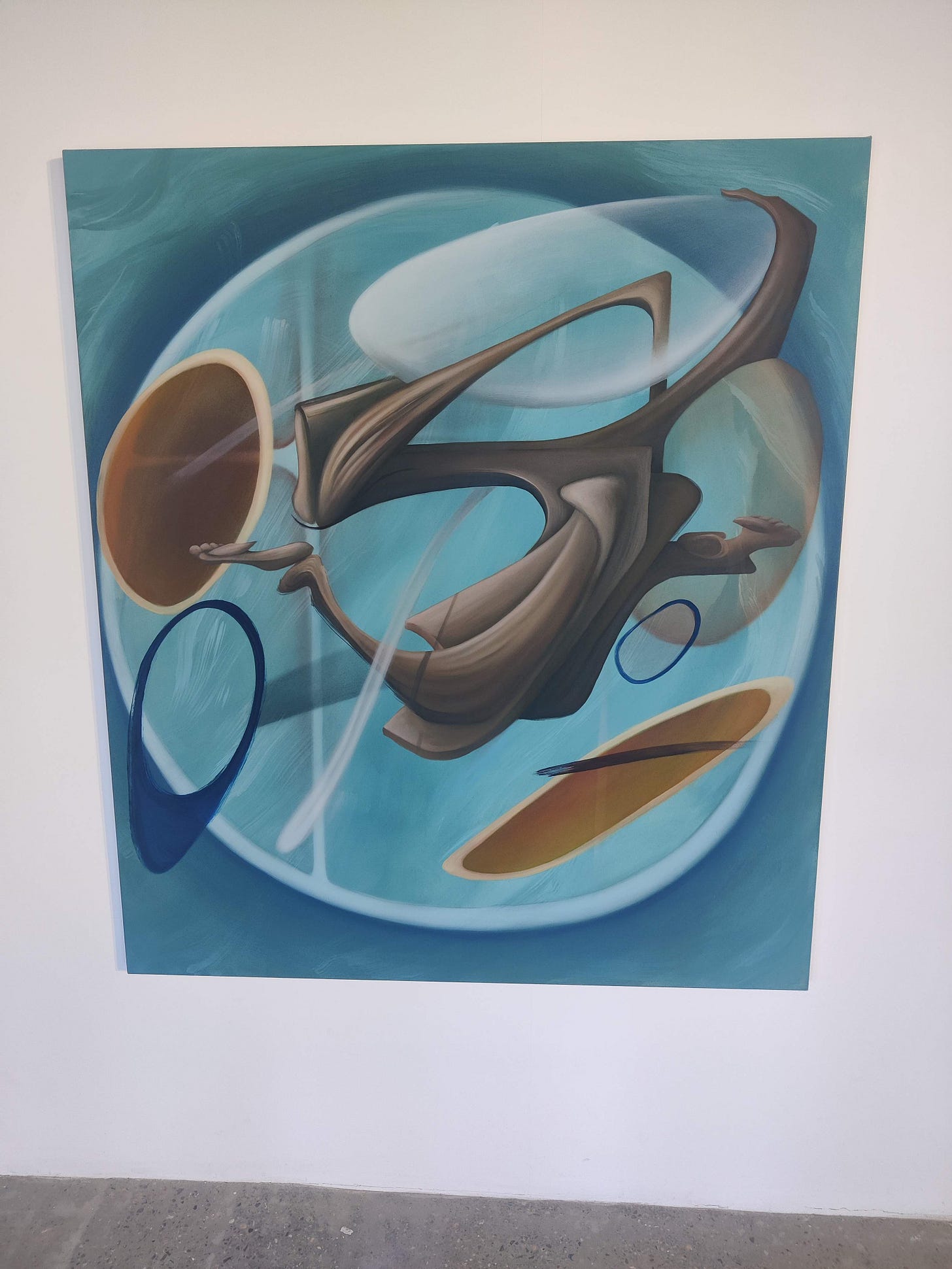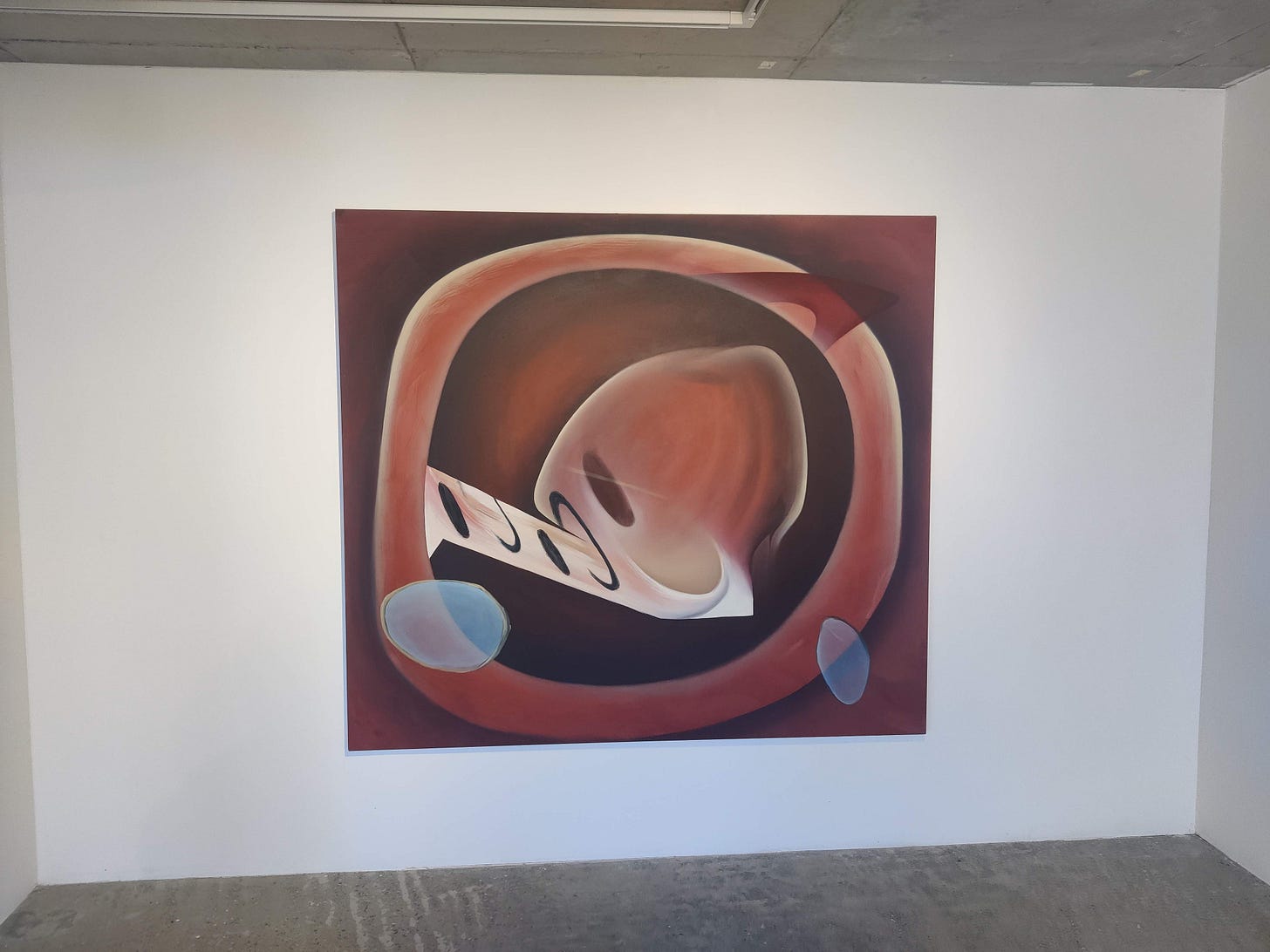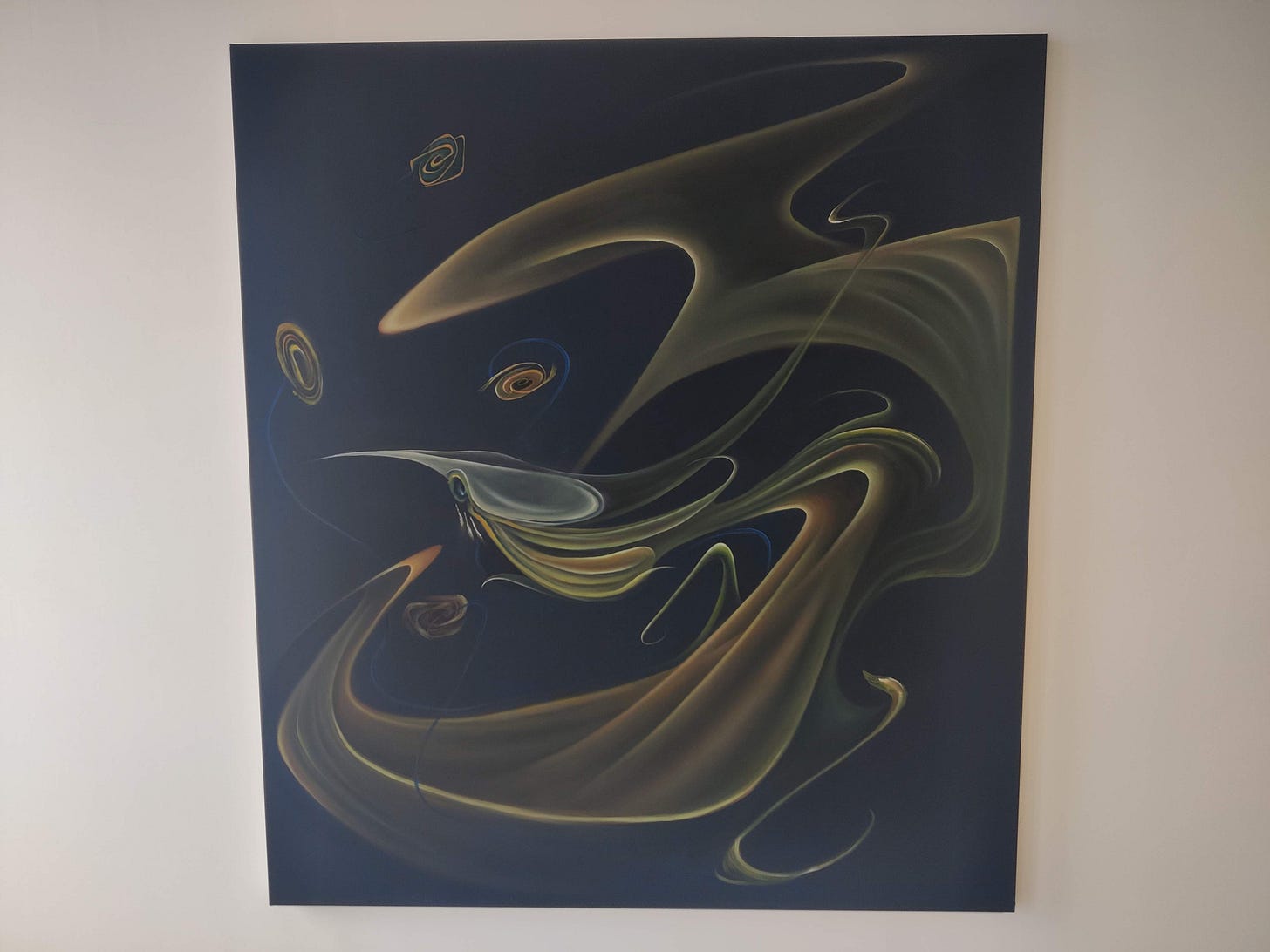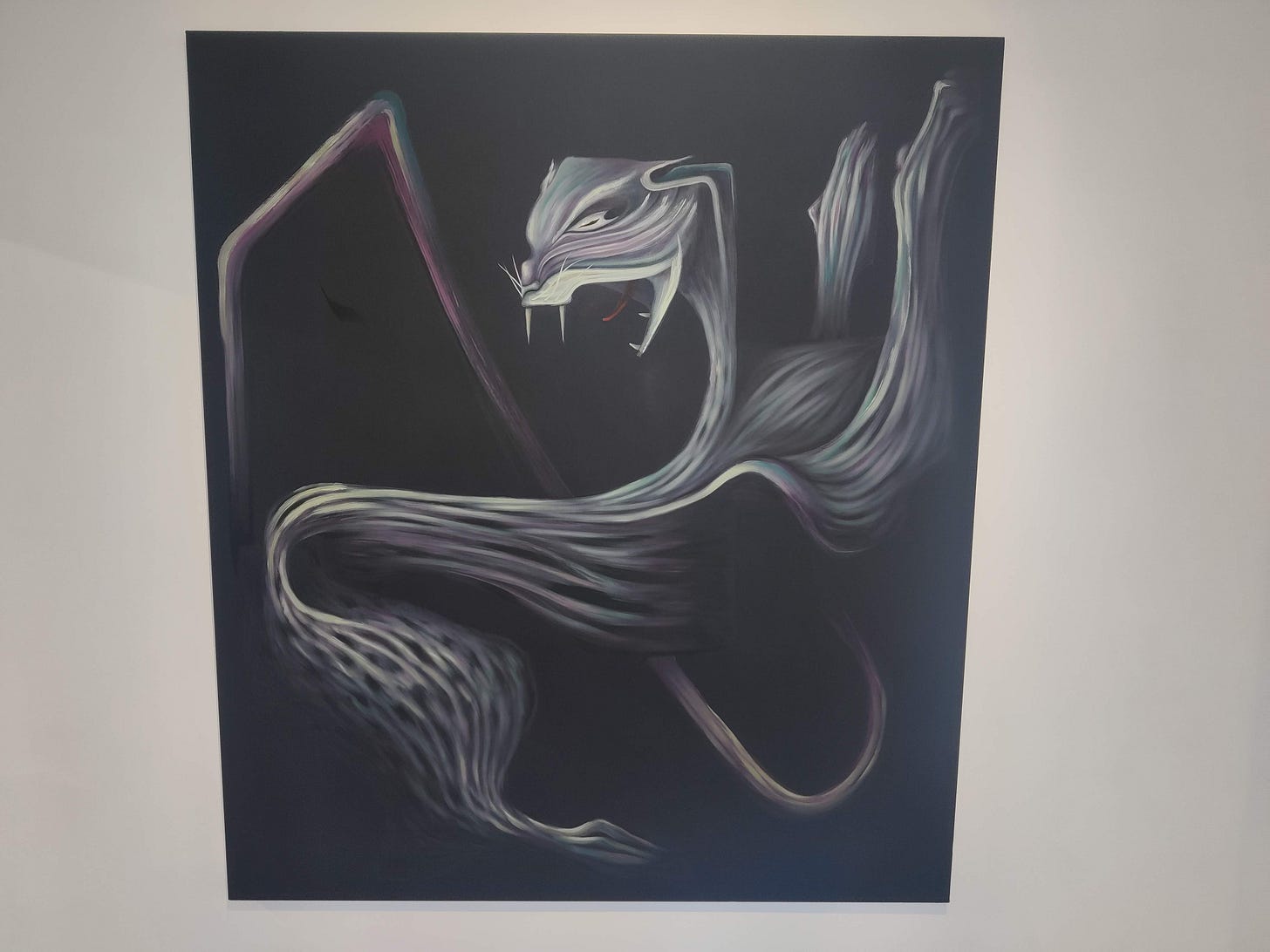Alfie Rouy – 'Earth Eater'
22nd March - 16th April, 2024
Painter Alfie Rouy has a new show at Guts Gallery. There are cosmic swirls and big beasties and lots of controlled chaos and boisterous beauty. I spoke to him about it and here’s what he had to say.
JT - This is your first solo show in the UK but you’ve had a big solo show in Korea. How did that happen?
AR - Luckily someone at the gallery Duarte Sequeira caught wind of my work. They saw a painting of a tiger at Liliya Art Gallery in 2022, and straight off the bat they were like ‘do you want a solo show in Korea?’ and I was like ‘sweet, sure!’. So that’s where it started. I wasn’t expecting my first solo show to be in Korea.
JT - I was gonna ask you about the animals. They’re a big part of this show, but there seems to be this relationship between dislocated or sort of dismembered parts, not in a violent way, but almost like the animals are coming apart themselves. What process takes you there?
AR - I think initially I was painting animals and it was more ‘realistic’ but for me it gets a bit tiresome when you constantly do the same thing over and over. So I wanted to experiment with the form and then see how I could incorporate more of the ideas behind my work: change and development and evolution, whether it’s physically or spiritually. So I tried to embody that, and then the same thing happened with my people. I just try to find ways that at first look good or interesting, and aren’t just the same old thing that’s been done over and over, and find something that can kind of convey the meaning behind it at the same time. The animals have taken on this personifying of evolution or chaos or fear or peace or love. I didn’t intend to go down this route but it’s where it’s led me. The way those things can go hand in hand, is if the animal itself is physically changing or different from what we would perceive it to be.
JT - And the human forms as well, there’s a similar thing – you repeat the motif of the shape that they take, twisting through the space, across a couple of the paintings. What was behind that shift?
AR - Again it’s similar, it’s trying to embody that change and development. But for instance the big one, it’s kind of an experiment, well all my paintings are experiments. It’s trying to combine my more abstract work with the figurative work I’ve been doing. And I think naturally these forms of repetition, especially the spiral oval shape, they fit hand-in-hand with this thing that comes out of me. I’ve been trying to fit them together and I’m getting the gist of how they fit together. Trying to make it look interesting and look good.
JT - There’s also this kind of cosmic swirl, these sort of stellar or lunar objects, it seems like you’re pulling them together across the abstract and the figurative. How are you trying to balance it out?
AR - I can feel myself naturally going more abstract with it. I’m not sure they are defined as abstract work, but initially they look abstract. So I feel it coming out of me and I wanna get it out, but I’ve also finally got to a point where I’m happy with the figurative, and in a direction where I can take it somewhere quite nice. With the animals I can feel they’re maybe leaving a bit, but not being pushed away. More like I can see how they fit nicely together.
JT - Where’s your studio? I was thinking about the scale you’re painting on. There are nine pictures in the show, but they’re big!
AR - In Peckham. Yeah the biggest one is 200 x 250cm.
JT - Of late I feel like there’s been a shift towards people working in smaller forms and it feels really nice to see someone working at a bigger scale!
AR - Yeah. It’s something I’ve wanted to do for ages, and I have the space here to do it, I just don’t have the space to store loads and loads. If I could, I’d do more. It’s just so much more freeing being able to move your arms across the whole painting rather than just doing little movements.
JT - You can see it’s a lot more gestural and sweeping. Are they the biggest you’ve ever done?
AR - Yeah, the biggest consistent works.
JT - The book ‘The Law of One’ and some other esoteric elements are underpinning a lot of your thinking behind the show. How did you first engage with that and how does it get threaded through into your work?
AR - So it’s quite out there. I don’t take it as gospel at all. I like the ideas that are portrayed through it, especially around the soul’s evolution and the hierarchy of the categories within it, and the part that the Earth has to play in it all. It links up with the Age of Aquarius coming in. I find it really interesting how science is backing up certain aspects of it, like how the Schumann resonance, which is Earth’s frequency, has risen with this change. If the whole of the planet’s frequency is changing then I think everything else around it will change. There’s so much within that I find interesting, so I think if people know about it, it can act kind of like a peacemaker in a way, with so much chaos going on.
JT - Yeah like a connection with universal understanding of ‘oneness’, and a realisation that all the separation is an illusion?
AR - Exactly.
JT - Your siblings are both painters too. How did that happen?
AR - I don’t really know! George my older brother has always been like the ‘straight to it, painting and drawing’ type. Elsa started in fashion and then went into embroidery and went from there. Whereas I was always making stuff with my hands when I was young. I went from lego to set design and prop building, I was into all of that through my teenage years. It wasn’t until I got to sixteen or seventeen and I went to college and got more into drawing. From there, I went into illustration but it was a bit too commercial for me, so then I ended up painting. But I think ultimately I’m more of a hands-on person, so I think I’ll go into sculpture.
JT - That’s really cool, it makes a lot of sense with the physical interaction you like having with the work and the scale to be able to stretch your arms.
AR - That will eventually be coming out one day.
JT - They heard/read it here first!





